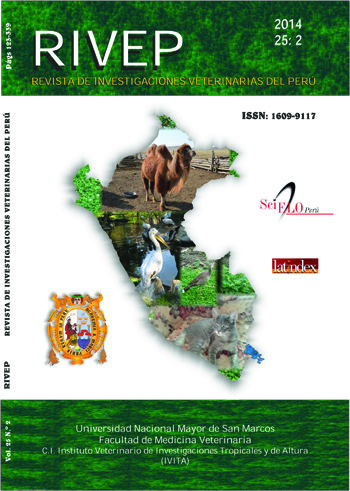ELMINTHIASIS AND EIMERIASIS IN ALPACAS OF TWO COMMUNITIES OF CUSCO, PERU
DOI:
https://doi.org/10.15381/rivep.v25i2.8497Keywords:
alpaca, helminth, Eimeria, Quispicanchis, sedimentation, logistic regressionAbstract
The aim of this study was to estimate the prevalence of helminthes and Eimeria inalpacas of two communities in Ocongate, Cusco, Peru, and to determine the associationbetween the presence of these parasites with location, ecosystem, age and sex. A total of1001 faecal samples were collected from Huacaya alpacas, 521 in the Pampacanchacommunity and 480 in Mahuayani community during the end of the dry season (September-October 2011). Samples were analyzed by the sedimentation and flotation techniqueswith Sheather and Willis solutions. The parasite load was determined by the modifiedMcMaster technique. Helminth genus was identified through the eggs, stool culture andinfective larvae. Eimeria identification was done by oocyst sporulation. The prevalencewas 68.4 and 61.5% for helminthes and Eimeria respectively. The multiple logistic regressiontests showed a significant association between helminthes and age and between Eimeriaand age and location(p < 0.05). Parasites of the following genus were found: Nematodirus,Tr ich uris, Capillaria, Laman ema, Cooperia, Ostertagia, Tr ich ostrongylus,Oesophagostomum, Bunostomum and Moniezia, where Nematodirus was the mostfrequent (p < 0.05). Eimeria alpacae was the most frequent Eimeria (42%). The nematodeload varied between 59.3 to 70.9 eggs per gram of faeces (epg) and Eimerias showed ageometric mean of 216 oocysts per gram of faeces (opg), both of them are considered oflow level of parasite load.Downloads
Downloads
Published
Issue
Section
License
Copyright (c) 2014 Helen Pérez R., Amanda Chávez V., Rosa Pinedo V., Víctor Leyva V.

This work is licensed under a Creative Commons Attribution-NonCommercial-ShareAlike 4.0 International License.
AUTHORS RETAIN THEIR RIGHTS:
a. Authors retain their trade mark rights and patent, and also on any process or procedure described in the article.
b. Authors retain their right to share, copy, distribute, perform and publicly communicate their article (eg, to place their article in an institutional repository or publish it in a book), with an acknowledgment of its initial publication in the Revista de Investigaciones Veterinarias del Perú (RIVEP).
c. Authors retain theirs right to make a subsequent publication of their work, to use the article or any part thereof (eg a compilation of his papers, lecture notes, thesis, or a book), always indicating the source of publication (the originator of the work, journal, volume, number and date).



